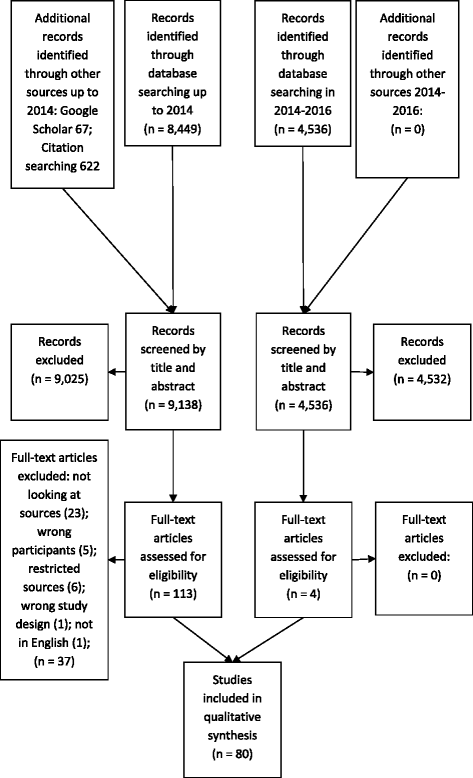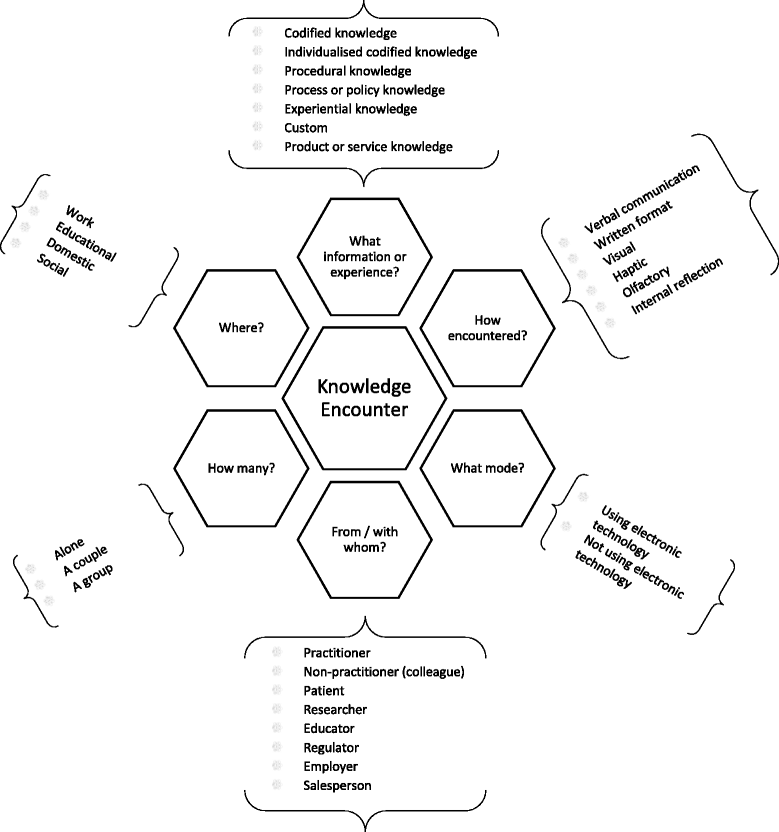Describing knowledge encounters in healthcare: a mixed studies systematic review and development of a classification
- PMID: 28292307
- PMCID: PMC5351057
- DOI: 10.1186/s13012-017-0564-1
Describing knowledge encounters in healthcare: a mixed studies systematic review and development of a classification
Abstract
Background: Implementation science seeks to promote the uptake of research and other evidence-based findings into practice, but for healthcare professionals, this is complex as practice draws on, in addition to scientific principles, rules of thumb and a store of practical wisdom acquired from a range of informational and experiential sources. The aims of this review were to identify sources of information and professional experiences encountered by healthcare workers and from this to build a classification system, for use in future observational studies, that describes influences on how healthcare professionals acquire and use information in their clinical practice.
Methods: This was a mixed studies systematic review of observational studies.
Data sources: OVID MEDLINE and Embase and Google Scholar were searched using terms around information, knowledge or evidence and sharing, searching and utilisation combined with terms relating to healthcare groups.
Eligibility: Studies were eligible if one of the intentions was to identify information or experiential encounters by healthcare workers.
Data extraction: Data was extracted by one author after piloting with another.
Study appraisal: Studies were assessed using the Mixed Methods Appraisal Tool (MMAT).
Primary outcome: The primary outcome extracted was the information source or professional experience encounter.
Analysis: Similar encounters were grouped together as single constructs. Our synthesis involved a mixed approach using the top-down logic of the Bliss Bibliographic Classification System (BC2) to generate classification categories and a bottom-up approach to develop descriptive codes (or "facets") for each category, from the data. The generic terms of BC2 were customised by an iterative process of thematic content analysis. Facets were developed by using available theory and keeping in mind the pragmatic end use of the classification.
Results: Eighty studies were included from which 178 discreet knowledge encounters were extracted. Six classification categories were developed: what information or experience was encountered; how was the information or experience encountered; what was the mode of encounter; from whom did the information originate or with whom was the experience; how many participants were there; and where did the encounter take place. For each of these categories, relevant descriptive facets were identified.
Conclusions: We have sought to identify and classify all knowledge encounters, and we have developed a faceted description of key categories which will support richer descriptions and interrogations of knowledge encounters in healthcare research.
Keywords: Evidence-based practice; Faceted classification; Healthcare workers; Information sources; Knowledge encounters; Mixed studies; Systematic review.
Figures
Similar articles
-
Measures implemented in the school setting to contain the COVID-19 pandemic.Cochrane Database Syst Rev. 2022 Jan 17;1(1):CD015029. doi: 10.1002/14651858.CD015029. Cochrane Database Syst Rev. 2022. Update in: Cochrane Database Syst Rev. 2024 May 2;5:CD015029. doi: 10.1002/14651858.CD015029.pub2. PMID: 35037252 Free PMC article. Updated.
-
Factors that influence parents' and informal caregivers' views and practices regarding routine childhood vaccination: a qualitative evidence synthesis.Cochrane Database Syst Rev. 2021 Oct 27;10(10):CD013265. doi: 10.1002/14651858.CD013265.pub2. Cochrane Database Syst Rev. 2021. PMID: 34706066 Free PMC article.
-
Eliciting adverse effects data from participants in clinical trials.Cochrane Database Syst Rev. 2018 Jan 16;1(1):MR000039. doi: 10.1002/14651858.MR000039.pub2. Cochrane Database Syst Rev. 2018. PMID: 29372930 Free PMC article.
-
Signs and symptoms to determine if a patient presenting in primary care or hospital outpatient settings has COVID-19.Cochrane Database Syst Rev. 2022 May 20;5(5):CD013665. doi: 10.1002/14651858.CD013665.pub3. Cochrane Database Syst Rev. 2022. PMID: 35593186 Free PMC article.
-
Experiences of gynecological cancer patients receiving care from specialist nurses: a qualitative systematic review.JBI Database System Rev Implement Rep. 2017 Aug;15(8):2087-2112. doi: 10.11124/JBISRIR-2016-003126. JBI Database System Rev Implement Rep. 2017. PMID: 28800057
Cited by
-
A comment-driven evidence appraisal approach to promoting research findings into practice when only uncertain evidence is available.Health Res Policy Syst. 2023 Mar 27;21(1):25. doi: 10.1186/s12961-023-00969-9. Health Res Policy Syst. 2023. PMID: 36973785 Free PMC article.
-
Advanced informatics understanding of clinician-patient communication: A mixed-method approach to oral health literacy talk in interpreter-mediated pediatric dentistry.PLoS One. 2020 Mar 20;15(3):e0230575. doi: 10.1371/journal.pone.0230575. eCollection 2020. PLoS One. 2020. PMID: 32196519 Free PMC article.
-
Willingness to Treat with Therapies of Unknown Effectiveness in Severe COVID-19: A Survey of Intensivist Physicians.Ann Am Thorac Soc. 2022 Apr;19(4):633-639. doi: 10.1513/AnnalsATS.202105-594OC. Ann Am Thorac Soc. 2022. PMID: 34543580 Free PMC article.
-
Locating Medical Information during an Infodemic: Information Seeking Behavior and Strategies of Health-Care Workers in Germany.Healthcare (Basel). 2023 May 30;11(11):1602. doi: 10.3390/healthcare11111602. Healthcare (Basel). 2023. PMID: 37297742 Free PMC article.
-
Implementation science: from evidence to practice.Acta Med Colomb. 2018 Oct-Dec;43(4):207-216. Acta Med Colomb. 2018. PMID: 31285636 Free PMC article.
References
Publication types
MeSH terms
LinkOut - more resources
Full Text Sources
Other Literature Sources



